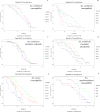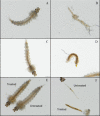The effects of larval organic fertiliser exposure on the larval development, adult longevity and insecticide tolerance of zoophilic members of the Anopheles gambiae complex (Diptera: Culicidae)
- PMID: 30998732
- PMCID: PMC6472872
- DOI: 10.1371/journal.pone.0215552
The effects of larval organic fertiliser exposure on the larval development, adult longevity and insecticide tolerance of zoophilic members of the Anopheles gambiae complex (Diptera: Culicidae)
Abstract
Zoophilic members of the Anopheles gambiae complex are often associated with cattle. As such, it is likely that the immature aquatic stages will be exposed to cattle faeces as a pollutant. This study aimed to examine the effect of cattle manure on members of the An. gambiae complex found in South Africa. In this study, a commercial organic fertiliser originating from cattle manure was used as a proxy for cattle faeces. Laboratory strains of An. merus, An. quadriannulatus as well as four An. arabiensis strains (SENN and MBN: insecticide susceptible, MBN-DDT: insecticide resistant, unselected, SENN-DDT: insecticide resistant: selected for resistance) were used in this study. The effect of larval fertiliser exposure on larval development rate and adult longevity was assessed in all three species. The effect of larval fertiliser exposure on subsequent adult size, insecticide tolerance and detoxification enzyme activity of the four strains of the malaria vector An. arabiensis was also assessed. Following fertiliser treatment, all strains and species showed a significantly increased rate of larval development, with insecticide susceptible strains gaining the greatest advantage. The adult longevities of An. merus, An. quadriannulatus, insecticide susceptible and resistant An. arabiensis were significantly increased following fertiliser treatment. Insecticide susceptible and resistant An. arabiensis adults were significantly larger after larval organic fertiliser exposure. Larval fertiliser exposure also increased insecticide tolerance in adult An. arabiensis, particularly in the insecticide resistant, selected strain. This 4.7 fold increase in deltamethrin tolerance translated to an increase in pyrethroid resistance intensity, which could exert operational effects. In general, larval exposure to cattle faeces significantly affects the life histories of members of the An. gambiae complex.
Conflict of interest statement
The authors have declared that no competing interests exist.
Figures






References
-
- Coetzee M, Hunt RH, Wilkerson R, Della Torre A, Coulibaly MB, Besansky NJ. Anopheles coluzzii and Anopheles amharicus, new members of the Anopheles gambiae complex. Zootaxa. 2013;3619:246–74. Epub 2013/01/01. . - PubMed
-
- Gillies MT, Meillon BD. The Anophelinae of Africa south of the Sahara (Ethiopian Zoogeographical Region). Publications of the South African Institute for Medical Research; 1968;54.
-
- Awolola TS, Oduola AO, Obansa JB, Chukwurar NJ, Unyimadu JP. Anopheles gambiae s.s. breeding in polluted water bodies in urban Lagos, southwestern Nigeria. J Vector Borne Dis. 2007;44(4):241–4. . - PubMed
-
- Jones CM, Toe HK, Sanou A, Namountougou M, Hughes A, Diabate A, et al. Additional selection for insecticide resistance in urban malaria vectors: DDT resistance in Anopheles arabiensis from Bobo-Dioulasso, Burkina Faso. PloS one. 2012;7(9):e45995 Epub 2012/10/11. 10.1371/journal.pone.0045995 PONE-D-12-13897 [pii]. - DOI - PMC - PubMed
Publication types
MeSH terms
Substances
LinkOut - more resources
Full Text Sources
Research Materials
Miscellaneous

